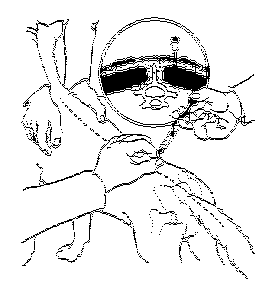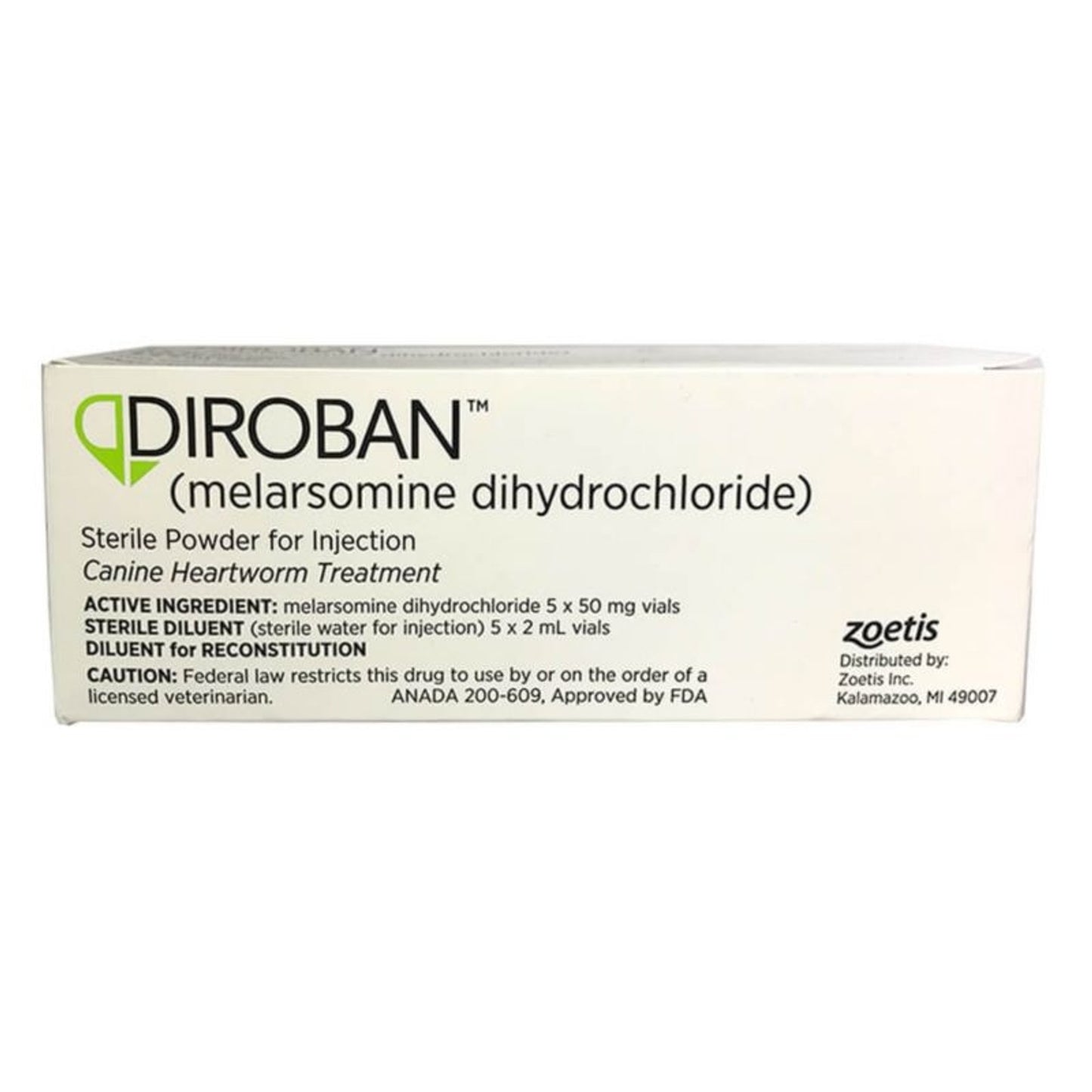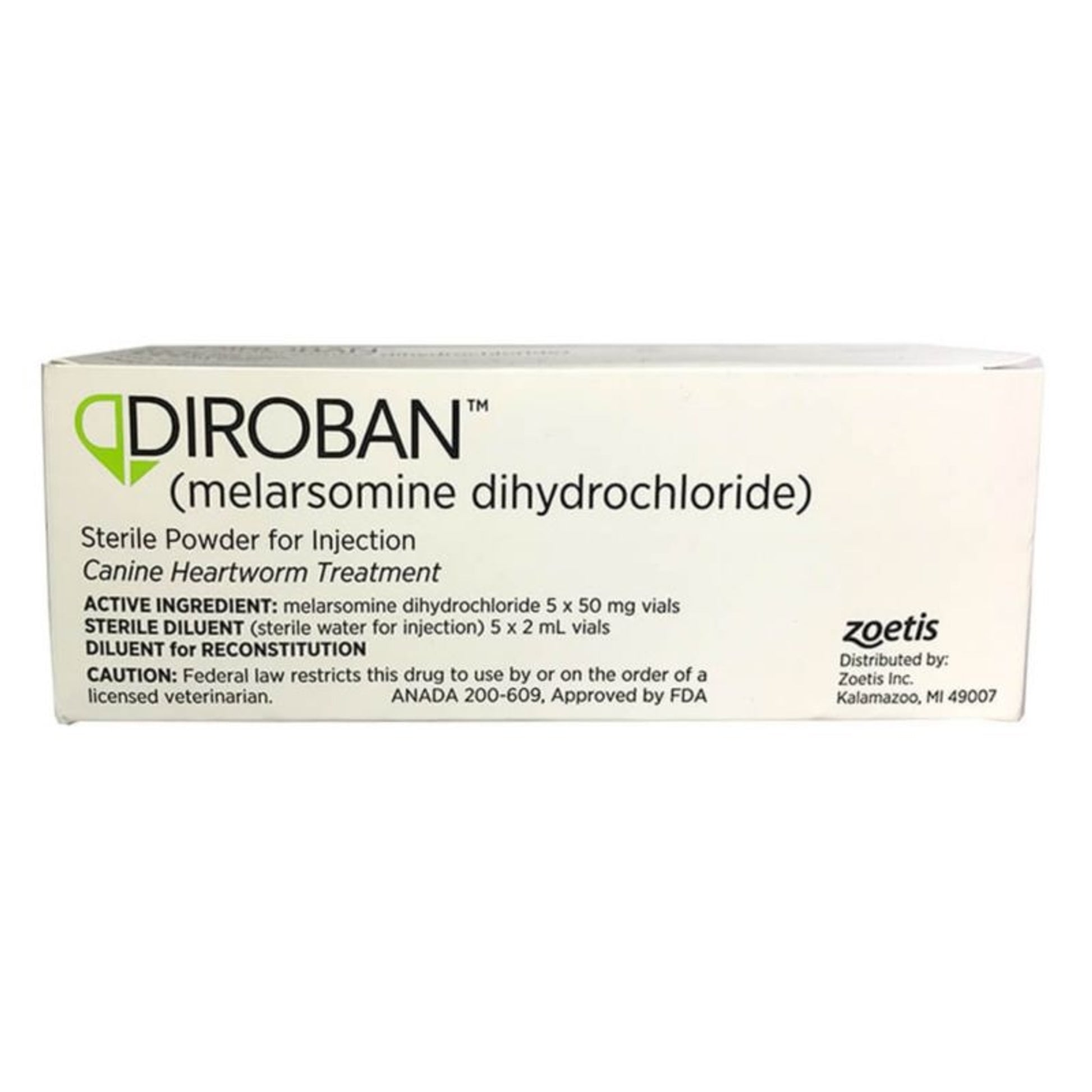Melarsomine dihydrochloride (the active ingredient in Diroban) is an organic arsenical chemotherapeutic agent. Melarsomine has a molecular weight of 501.34 and is chemically designated as 4 – [(4, 6-diamino-1, 3, 5- triazon-2-yl) amino] phenyldithioarsenite of di (2-aminoethyl), dihydrochloride. It is freely soluble in water. When injected intramuscularly, it is rapidly absorbed. The exact mode of action on D. immitis is unknown.
Heartworm Disease Classification: The following parameters were used to classify the dogs in the clinical field trials for Diroban. Other parameters may be considered. As a general rule, conservative treatment should be employed since heartworm disease is serious and potentially fatal. If there is evidence of a high worm burden, patients should be categorized as Class 3.
a Class 1: Patients in this category are characterized as having asymptomatic to mild heartworm disease. No radiographic signs or signs of anemia are evident. Patients with mild disease may have subjective signs such as a general loss of condition, fatigue on exercise, or occasional cough; however, no objective radiographic or other abnormal laboratory parameters will be present.
b Class 2: Patients in this category are characterized as having moderate heartworm disease. Radiographic signs or signs of anemia [Packed Cell Volume (PCV) less than 30% but greater than 20%, or other hematologic parameters below normal] are evident. Mild proteinuria (2+) may be present. Radiographic signs may include right ventricular enlargement, slight pulmonary artery enlargement, or circumscribed perivascular densities plus mixed alveolar/interstitial lesions. Patients may be free of subjective clinical signs or may have a general loss of condition, fatigue on exercise, or occasional cough. If necessary, patients should be stabilized prior to treatment.
c Class 3: Patients in this category are characterized as having severe heartworm disease. These patients have a guarded prognosis. Subjective signs of disease may include cardiac cachexia (wasting), constant fatigue, persistent cough, dyspnea, or other signs associated with right heart failure such as ascites and/or jugular pulse. Radiographic signs may include right ventricular enlargement or right ventricular plus right atrial enlargement, severe pulmonary artery enlargement, circumscribed to chronic mixed patterns and diffuse patterns of pulmonary densities or radiographic signs of thromboembolism. Signs of significant anemia (PCV <20% or other hematologic abnormalities) may be present. Proteinuria (> 2+) may be present. Patients may have only moderate clinical signs and significant laboratory or radiographic alterations or they may have significant clinical signs with only moderate laboratory and radiographic signs and be categorized as Class 3. Patients in Class 3 should be stabilized prior to treatment and then administered the alternate dosing regime
Ingredients
Diroban Sterile Powder contains 50.0 mg melarsomine dihydrochloride and 33.75 mg glycine USP.
1 vial: when reconstituted with 2 mL of sterile water for injection (provided) contains 25 mg/mL of active ingredient.
Warning
For use in dogs only. Safety for use in breeding animals and lactating or pregnant bitches has not been determined.
Human Warnings
Keep this and all medications out of the reach of children. Avoid human exposure. Wash hands thoroughly after use or wear gloves. Potentially irritating to eyes. Rinse eyes with copious amounts of water if exposed. Consult a physician in cases of accidental exposure by any route (dermal, oral, or by injection). The Material Safety Data Sheet (MSDS) contains more detailed occupational safety information. To report adverse effects, obtain an MSDS or for assistance, contact Merial at 1-888-637-4251, option 3.
DIROBAN Dosage And Administration
Diroban should be administered ONLY by deep intramuscular injection in the epaxial (lumbar) muscles in the third through fifth lumbar region (see graphic). DO NOT ADMINISTER AT ANY OTHER SITE. Avoid superficial injection or leakage. Use a 23 gauge 1 inch needle for dogs equal to or less than 10 kg (22 lb) in weight. Use a 22 gauge 1 1/2 inch needle for dogs greater than 10 kg (22 lb). Use alternating sides with each administration. If repeated administrations are warranted avoid injecting at the same lumbar location. Record the location of the first injection(s) in the patient’s medical record for future reference.

Disease Classification: It is vital to classify the severity of heartworm disease to apply the appropriate dosage regime for Diroban (See INDICATIONS).
Class 1 and 2:
If necessary, dogs should be stabilized prior to treatment. DIROBAN should be administered intramuscularly in the lumbar (L3 - L5) muscles at a dose of 2.5 mg/kg twice, 24 hours apart (See Dosing Table). Four months following treatment, a second treatment series (2.5 mg/kg twice, 24 hours apart) can be elected taking into consideration the response to the first DIROBAN treatment and the condition, age, and use of the dog. Worms that were too young to be killed by the first treatment series, i.e., < 4 months, may be killed by a second treatment series.
Class 3:
Alternate Dosing Regime: Dogs with severe (Class 3) heartworm disease should be stabilized prior to treatment and then dosed intramuscularly in the lumbar (L3 - L5) muscles with a single injection of 2.5 mg/kg then approximately 1 month later with 2.5 mg/kg administered twice 24 hours apart (See Dosing Table).
Dosing Table: Care must be taken to administer the proper dose. Accurately weigh the dog and calculate the volume to be injected based on the dose of 2.5 mg/kg (1.1 mg/lb). This is equivalent to 0.1 mL/kg (0.045 mL/lb). The following table should be used as a guide to ensure that the proper volume has been calculated.
| WEIGHT (LB) | WEIGHT (KG) | VOLUME PER INJECTION |
| 2.2 | 1 | 0.1 |
| 4.4 | 2 | 0.2 |
| 6.6 | 3 | 0.3 |
| 8.8 | 4 | 0.4 |
| 11.0 | 5 | 0.5 |
| 13.2 | 6 | 0.6 |
| 15.4 | 7 | 0.7 |
| 17.6 | 8 | 0.8 |
| 19.8 | 9 | 0.9 |
| 22.0 | 10 | 1.0 |
| 44.0 | 20 | 2.0 |
| 66.0 | 30 | 3.0 |
| 88.0 | 40 | 4.0 |
| 110.0 | 50 | 5.0* |
*Limited data were collected on the administration > 5.0 mL at a single injection site.
Preparation: DIROBAN should be aseptically reconstituted only with 2.0 mL of sterile water for injection (provided as 2.0 mL sterile water for injection USP). This provides 2.5 mg melarsomine dihydrochloride per 0.1 mL of injectable solution. Two 50 mg vials will be required for dogs weighing > 20 kg and 40 kg and 3 vials will be required for dogs > 40 kg and 60 kg. Use immediately. Reconstituted solution may be used within 24 hours if refrigerated and kept from light.
Treatment Response: A baseline can be established pre-treatment by using commercially available in-office heartworm antigen test kits prior to treatment. Treatment response can be assessed best by heartworm antigen testing applied 4 months after treatment. A successful treatment is determined to be conversion from an antigen positive to an antigen negative status. In dogs with signs of heartworm disease, gradual improvement should be observed as the long-term effects of the heartworm infection resolve. Some dogs may have chronic effects that will not totally resolve.
CONCOMITANT THERAPY: During the course of clinical field trials, DIROBAN was administered concurrently with anti-inflammatories, antibiotics, insecticides, heartworm prophylactics, and various other drugs commonly used to stabilize and support dogs with heartworm disease with no adverse drug interactions noted.
Routine Prophylaxis: If the dog is not currently receiving commercially available heartworm preventatives, they may be administered consistent with label recommendations and re-exposure risk.
Cautions
ADVERSE REACTIONS (SIDE EFFECTS): Injection Sites: At the recommended dosage in clinical field trials, significant irritation was observed at the intramuscular injection sites, accompanied by pain, swelling, tenderness, and reluctance to move. Approximately 30% of treated dogs experienced some kind of reaction at the injection site(s). Though injection site reactions were generally mild to moderate in severity and recovery occurred in 1 week to 1 month, severe reactions did occur (< 1.0%), so care should be taken to avoid superficial or subcutaneous injection and leakage. Firm nodules can persist indefinitely. Other Reactions: Coughing/gagging, depression/lethargy, anorexia/inappetence, fever, lung congestion, and vomiting were the most common reactions observed in dogs treated with melarsomine dihydrochloride. Hypersalivation and panting occurred rarely in clinical trials (1.9% and 1.6%, respectively); however, these signs may occur within 30 minutes of injection and may be severe. One dog vomited after each injection of melarsomine dihydrochloride, despite pretreatment with anti-emetics. All adverse reactions resolved with time or treatment with the exception of a limited number of injection site reactions (persistent nodules).
CONTRAINDICATIONS: DIROBAN is contraindicated in dogs with very severe (Class 4) heartworm disease. Patients in this category have Caval Syndrome (D. immitis present in the venae cavae and right atrium).
Storage Conditions
Store upright at controlled room temperature (20°- 25°C). After reconstitution, solutions should be stored under refrigeration and kept from light in the original packaging for 36 hours. Do not freeze reconstituted solution. No antimicrobial or other substance has been added to the sterile water diluent.



